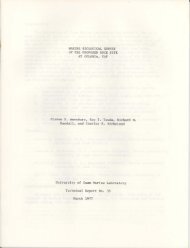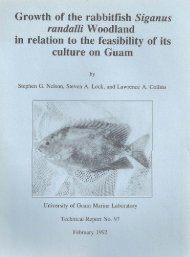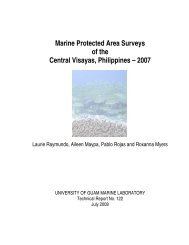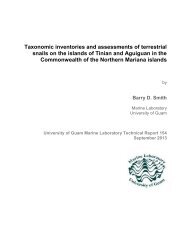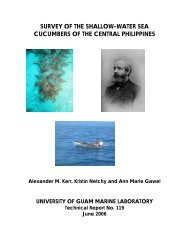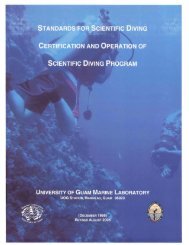Phylogeny of Holothuroidea (Echinodermata) inferred from ...
Phylogeny of Holothuroidea (Echinodermata) inferred from ...
Phylogeny of Holothuroidea (Echinodermata) inferred from ...
Create successful ePaper yourself
Turn your PDF publications into a flip-book with our unique Google optimized e-Paper software.
CALCAREOUS RING<br />
The calcareous pharyngeal ring is a defining feature<br />
<strong>of</strong> <strong>Holothuroidea</strong> and is possessed by all extant species,<br />
excepting the Pelagothuriidae. The evolutionary origin<br />
PHYLOGENY OF SEA CUCUMBERS 69<br />
order there are a few species with quadrate radial<br />
plates more typical <strong>of</strong> families in Aspidochirotida.<br />
15. Anterior margin <strong>of</strong> radial plates widened and with<br />
<strong>of</strong> the structure is uncertain, although it may be de- depressions to accommodate tentacular ampullae: 0=<br />
rived <strong>from</strong> elements <strong>of</strong> the echinoid lantern (Littlewood absent; 1=present. Wide depressions for the tentacular<br />
et al., 1997, their character 52) or peribuccal am- ampullae <strong>of</strong>ten give the radial plates a squared anterior<br />
bulacral plates (Fell & Moore, 1966; Haude, 1994). The margin. If the depressions are deep, they and the<br />
calcareous ring supports the pharynx, water vascular central groove for the radial nerve give a scalloped<br />
ring and tentacle ampullae, as well as providing in- appearance to the anterior edge.<br />
sertion points for the longitudinal and retractor<br />
muscles. The oldest known intact calcareous rings are<br />
16. Articulation <strong>of</strong> plates: 0=height <strong>of</strong> articulation<br />
<strong>from</strong> the Lower Devonian and possess, like nearly all<br />
small in proportion to interradial height; 1=area <strong>of</strong><br />
extant species, five radial and five interradial pieces<br />
articulation along considerable length <strong>of</strong> interradial<br />
(Haude, 1995b). Some large living synaptids, however,<br />
plate. In most Dendrochirotida, the radial and inmay<br />
possess extra, usually dorsal, interradial elements<br />
terradial plates join only at their posterior-most lateral<br />
to accommodate extra oral tentacles. Reduction in the<br />
margins. In apodans, plates adjoin along their entire<br />
number <strong>of</strong> ring elements also occurs and is discussed<br />
lateral margins, giving the calcareous ring a ‘bandbelow<br />
under character 11.<br />
like’ appearance.<br />
11. Level <strong>of</strong> calcification: 0=indistinct, reduced or absent;<br />
1=robust, well calcified and elements discrete.<br />
OSSICLES<br />
Calcareous rings are indistinct in families belonging 17. Ossicle arrangement in body wall: 0=isolated; 1=<br />
to the Elasipodida with the exception <strong>of</strong> Elpidiidae. In overlapping towards oral–aboral ends and mid-dorsal<br />
this family the ring is reduced to five distinct, stellate interradius; 2=overlapping irregularly. Most holo-<br />
radial pieces resembling the primordia found in jupreserved<br />
thuroids have ossicles dispersed in the body wall. In<br />
venile non-elasipodan holothuroids (Clark, 1898) and<br />
specimens examined <strong>of</strong> the dendrochirotes<br />
is coded herein as reduced.<br />
Heterothyonidae, Paracucumaridae, Placothuriidae,<br />
Psolidae, Rhopalodinidae and the dactylochirote Ypsilothuriidae,<br />
there is a test <strong>of</strong> overlapping ossicles con-<br />
12. One or more radial pieces perforated: 0=perforate;<br />
verging at the mouth, anus and midpoint <strong>of</strong> the dorsal<br />
1=notched. With the exception <strong>of</strong> the three taeniointerradius.<br />
With the exception <strong>of</strong> the ventrally aplagyrine<br />
genera in Chiridotidae (Smirnov, 1998) and<br />
cate Psolidae, these plates radiate <strong>from</strong> near the centre<br />
possibly the tiny myriotrochid Paratrochus (Gage &<br />
<strong>of</strong> the midventral radius. In Psolus peronii Bell, the<br />
Billett, 1986), families in Apodida possess radial plates<br />
ossicles are appressed exteriorly and the imbrication<br />
perforated for the passage <strong>of</strong> the radial nerve (not the<br />
is only visible <strong>from</strong> the interior. In contrast to the<br />
radial water vessel as reported by some authors).<br />
aforementioned families, Deimatidae plates stack with<br />
Perforations are not visible on the radial plates <strong>of</strong> the<br />
no discernible regularity – an autapomorphy. There<br />
outgroup exemplar Palaeocucumaria (Haude, 1995a).<br />
are two minor, but interesting, exceptions to these<br />
The oldest known perforate rings are <strong>from</strong> Nudicorona<br />
trends seen among holothuroids not considered in the<br />
seilacheri Haude, a somewhat younger fossil <strong>from</strong> the<br />
present study. First, in the dendrochirote genera Lo-<br />
Middle Devonian (Haude, 1997). The oldest known<br />
isettea and Leptopentacta, the ossicles abut rather than<br />
radial plates, occurring as isolated elements, are <strong>from</strong><br />
overlap, even in quite contracted specimens. Second,<br />
the Upper Silurian and appear imperforate (Reich,<br />
the Middle Triassic Strobilothyone rogenti Smith &<br />
1999).<br />
Gallemí, assigned to the dendrochirote family Heterothyonidae,<br />
has ossicles that imbricate in a manner<br />
13. Long posterior processes on radial plates: 0=ab- not seen in extant dendrochirotes or any other hosent;<br />
1=present. Long posterior extensions <strong>of</strong> the radial lothuroid (Smith & Gallemí, 1991). Ossicles, beginning<br />
plates are usually paired and may be entire, as in the along the circumference at mid-body, jut straight out<br />
Molpadiida and sclerodactylid Pentamera, or composed then gradually begin overlapping towards the oral<br />
<strong>of</strong> a mosaic <strong>of</strong> pieces, as in many phyllophorids. and aboral ends. At least one specimen <strong>of</strong> S. rogenti,<br />
however, has ossicles that overlap <strong>from</strong> mouth to anus<br />
14. Proportions <strong>of</strong> radial plate: 0=length and width (Smith & Gallemí, 1991, pl. 3, fig. 2), another type <strong>of</strong><br />
equal to subequal; 1=length much greater than width. imbrication not seen in any other holothuroid. This<br />
Most members <strong>of</strong> Molpadiida and Dendrochirotida possess<br />
second form <strong>of</strong> imbrication suggests that it or the other<br />
long narrow ring plates, although in the latter is a taphonomic artefact or, quite speculatively,<br />
that





